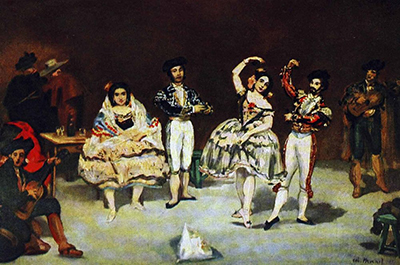Manet painted a Spanish dance company, although they were performing in Paris at the time, he got them to come to his studio and pose for him several times over.
Among the dancers are Lola de Valence, who is seated, also featured is the famous dancer Mariano Camprubi. The painting was created in 1862 and reflects the fascination Manet had with Spanish art and culture at the time. His exploration of these romantic stereotypes reflected the exotic enchantment of the Spanish that was popular within France as far back as the 1830's. He used an uncharacteristically cheerful choice of colors, the patchwork of reds, yellows, blues and black is not real colour but instead a caricature of colour.
The colour palette really showed Manet's joyful mood at the time of painting, in comparison to other works with a much more lurid and sinister feel to them due to their colour palette. In order to create this painting Manet made a precursory drawing, the drawing was then heightened by watercolour and gouache paint. Having painted the company in this painting Manet then went on to ask Lola de Valence to pose for him several times.
Le Ballet Espagnol fits in with Manet's revolutionary approach, much like other Edouard Manet artworks such as: Masked Ball at the Opera, Music in the Tuileries Gardens, The Luncheon on the Grass and many others. He has long been associated with impressionism, however he had a lot of influence from the realism and naturalism of his French contemporaries forming the foundation for his revolutionary approach. Manet often used urban modern life as his subject, and Le Ballet Espagnol can fit within this idea. The painting is of Spanish dancers performing within the Hippodrome in Paris, and much like Manet's paintings of urban life at the time, the painting is capturing a candid moment in action.
Unlike some of his paintings Le Ballet Espagnol contains energy and movement, the painting is fresh and dynamic with a sense of rhythm behind it. The figures at the forefront are bright and lit up drawing our focus, while the figure in the background are in gloomier, darker colours looking rather mysterious. This early Manet painting has romantic and expressionistic qualities that draw people in, with it's unexpected colour accents and linear patterning.




